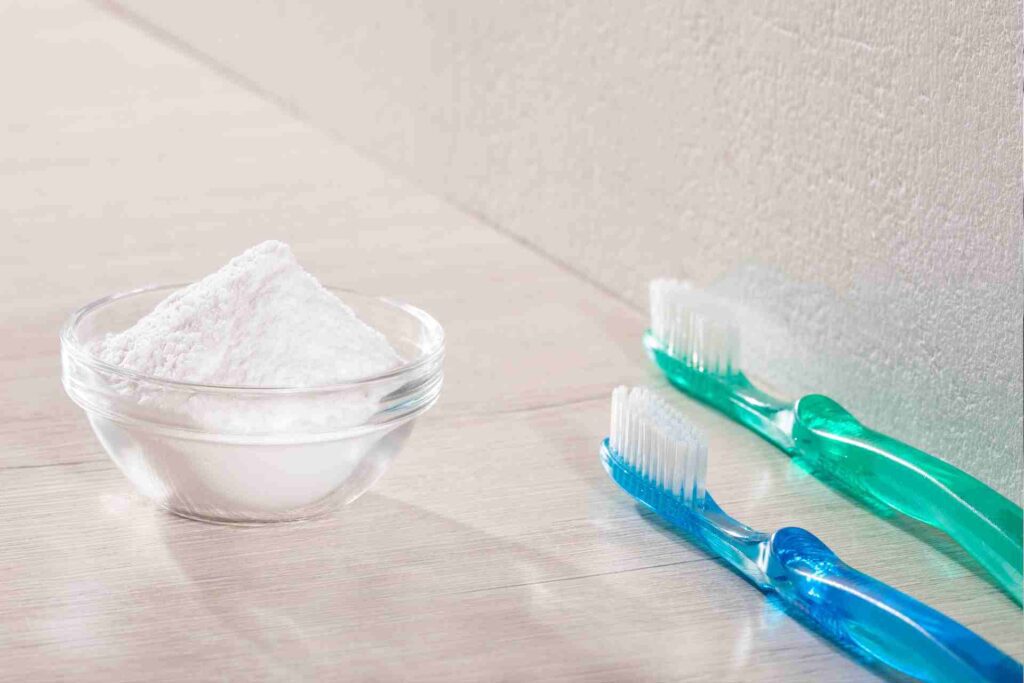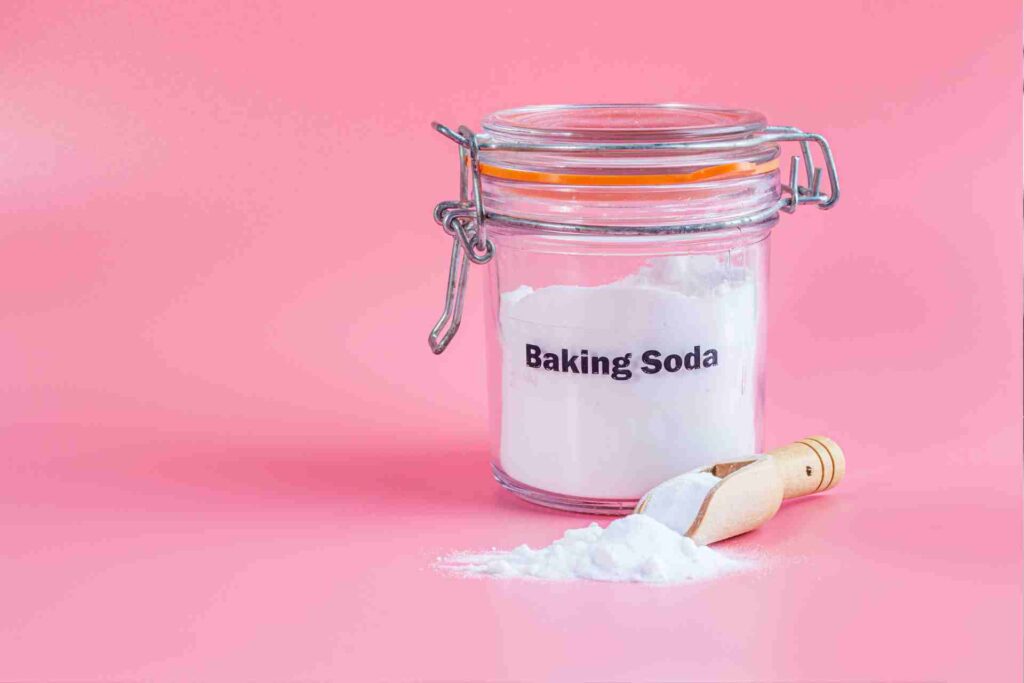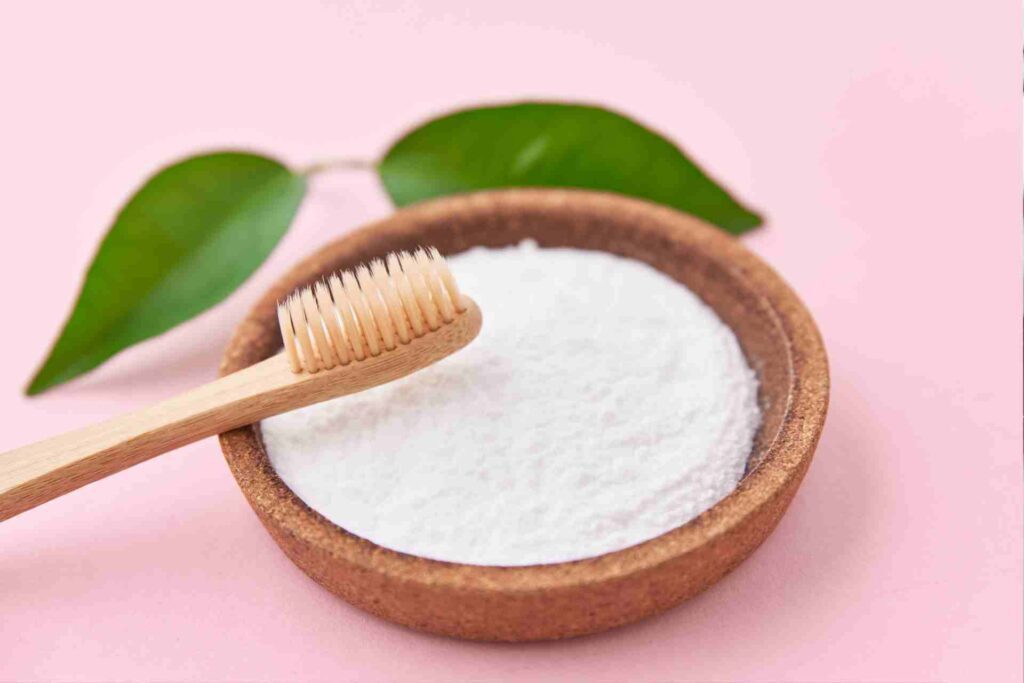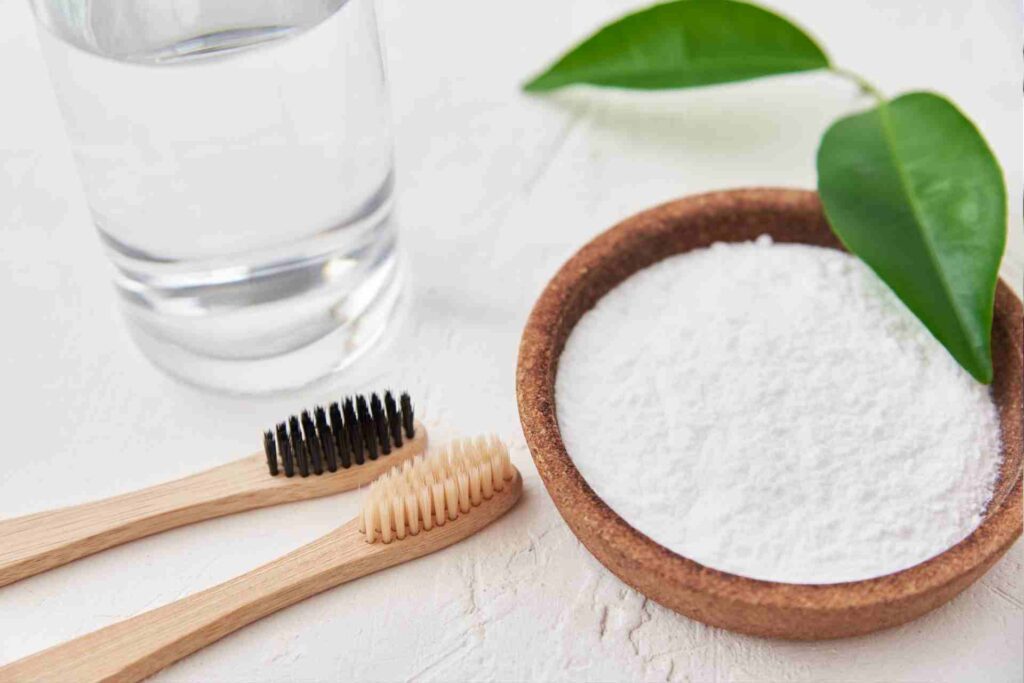Highlights:
- Baking soda is a great option for whitening teeth because it gently removes surface stains.
- It’s a natural, affordable, and easy-to-find alternative to store-bought whitening products.
- Just be careful not to overdo it—using baking soda too often can wear down your enamel. Stick to 2-3 times a week.
- Keep in mind, baking soda works on surface stains but won’t help with deep or stubborn discoloration.
- For the best results, try using baking soda alongside fluoride toothpaste to protect your enamel while brightening your smile.
Baking soda, or sodium bicarbonate, is one of those versatile household items everyone should have. It’s that white powder sitting in your pantry, ready to tackle a surprising variety of tasks.
Its natural alkaline properties are perfect for balancing out acids. This makes it a great tool not only for cooking but also for other practical uses.
- A gentle abrasive: Baking soda’s mild texture makes it ideal for cleaning and addressing tough stains around the house.
- Oral health benefits: When used properly, it can help keep your teeth clean and bright, serving as a natural addition to your oral care routine.
While many people think of baking soda as just a baking ingredient, its range of uses goes far beyond the kitchen!
How Does Baking Soda Work for Teeth Whitening?

Baking soda is an easy and affordable way to brighten your smile from the comfort of home. While it might not replace a professional dental cleaning, it’s a simple tool that can make a noticeable difference in your oral health.
- It gently scrubs away surface stains from things like coffee, tea, and berries, working like an exfoliator for your teeth.
- Its fine texture polishes your teeth without damaging enamel, leaving your smile smoother and brighter.
- By neutralizing acids in your mouth, it helps maintain a natural pH balance, which offers extra protection for your enamel over time.
Baking soda may not have the glamour of professional treatments, but its many benefits make it a powerful helper for maintaining your oral health.
Benefits of Using Baking Soda for Teeth Whitening
Safe and Natural Whitening
Baking soda is a simple, natural way to whiten your teeth without relying on chemical-heavy products. Its mild abrasiveness helps gently lift surface stains, making it a safer option compared to harsher alternatives.
Studies even show that toothpaste with baking soda works better at removing stains and plaque than those without it.
If you’re looking for an easy, eco-friendly way to brighten your smile, baking soda might just be the perfect choice!
Affordable and Easily Accessible

One of the best things about baking soda is that it’s cheap and easy to find. Unlike pricey whitening kits or treatments, baking soda is affordable and already sitting in most people’s kitchens.
Plus, one box lasts for weeks, making it a budget-friendly way to keep your smile looking brighter without breaking the bank.
Minimal Risk of Sensitivity
Some whitening treatments can make your teeth feel super sensitive, but baking soda is a gentler option. Its mild abrasiveness helps polish away stains without harming your enamel.
That’s why it’s a great choice if you have sensitive teeth and want a safer way to whiten. Just be sure to use it in moderation to keep your smile healthy!
Limitations and Risks of Using Baking Soda
Can Baking Soda Damage Teeth?
Baking soda can be a helpful tool for your teeth, but moderation is essential. Too much of a good thing can cause damage, even if it’s only mildly abrasive. Overusing it can wear down your enamel, which doesn’t grow back. That’s why it’s crucial to be cautious when using it as part of your oral care routine.

Here are a few tips to help you use baking soda safely:
- Limit use to 2–3 times a week—this is enough to maintain results without risking damage.
- Use a soft-bristled toothbrush and brush gently to avoid putting pressure on your enamel.
Remember, enamel is irreplaceable.
Ineffectiveness for Deep Stains
Baking soda can work wonders for surface stains like those caused by coffee, tea, or tobacco. Its mild abrasiveness helps lift stains from the enamel, but it has its limits.
If your discoloration goes deeper—such as stains caused by aging, medications, or tooth injuries—baking soda won’t be enough. For these tougher cases, you may need professional treatments.
Consider professional options like:
- Whitening gels
- Dental bleaching
- Veneers
These solutions target deeper stains and can deliver noticeable results.
Before jumping into any treatment, it’s always best to speak with your dentist. They can recommend the safest and most effective approach to achieve the brighter smile you’re after.
How to Use Baking Soda for Teeth Whitening Safely

Step-by-Step Tutorial for Whitening with Baking Soda
Materials needed:
- Baking soda
- Toothbrush
- Water
Steps:
- Mix 1/2 teaspoon of baking soda with a few drops of water to create a paste.
- Apply the paste to your toothbrush and gently brush your teeth for 2 minutes.
- Rinse thoroughly with water to remove the paste completely.
- Limit use to 2-3 times per week to avoid potential enamel damage.
Think of it like a DIY spa treatment for your teeth—simple, effective, and wallet-friendly. Regular use within safe limits can help reduce surface stains caused by coffee or tea while brightening your smile!
Baking Soda + Toothpaste
Want to step up your brushing game? Try adding a little baking soda to your regular fluoride toothpaste.
Baking soda’s gentle abrasiveness helps tackle stains, giving your teeth a brighter look. Meanwhile, fluoride prevents cavities and strengthens your enamel.
Just sprinkle a pinch of baking soda onto your toothpaste and brush as you normally would. It’s an easy, safe way to keep your smile brighter every day!
Baking Soda + Lemon Juice

Warning: Avoid this method!
While some DIY guides recommend mixing baking soda and lemon juice, the high acidity of lemon juice can erode enamel over time, leading to tooth sensitivity and damage. Protect your oral health by steering clear of this risky combination.
Baking Soda + Hydrogen Peroxide
If you’re considering a stronger whitening option, mix baking soda with hydrogen peroxide for a deeper clean. This method is simple and provides noticeable results when used correctly.
To make the paste:
- Combine 1/2 teaspoon of baking soda with a few drops of 3% hydrogen peroxide until it forms a paste.
- Apply it to your teeth and brush gently for up to 2 minutes.
- Rinse thoroughly to remove all residue.
Use it sparingly!
This method should only be used once a week to protect your enamel from overuse. As always, check with your dentist before trying new whitening techniques to ensure it’s safe for your teeth.
Tips for Maximizing Results and Protecting Enamel
Best Practices for Using Baking Soda
If you want to safely use baking soda for teeth whitening without damaging your enamel, here are a few tips:
- Use it sparingly – Too much can wear down your enamel, so stick to using it just 1-2 times a week.
- Combine it with fluoride toothpaste – Fluoride helps protect and strengthen your enamel, keeping your teeth healthy and strong.
- Keep up a good oral hygiene routine – Brush twice a day, floss daily, and visit your dentist regularly to maintain your oral health and keep your smile bright.
Dietary Changes for Long-Term Whitening
What you eat can really make a difference in keeping your teeth white. Here are a couple of easy tips to help maintain those results:
- Be mindful of stain-causing foods and drinks – Try to cut back on coffee, tea, red wine, and sugary sodas since they can discolor your teeth. If you can’t skip them, use a straw or rinse with water afterward to minimize the impact.
- Go for teeth-friendly snacks – Crunchy fruits and veggies like apples and celery are great because they help clean your teeth naturally by boosting saliva. Dairy products like cheese are also awesome for keeping your enamel strong.
When to Consult a Dentist

Sometimes baking soda isn’t quite enough to get the results you’re looking for or protect your oral health. It might be time to check in with your dentist if:
- You notice stubborn stains or discoloration – Some stains just won’t budge and could mean there’s something else going on or that you might need professional whitening.
- Your teeth feel sensitive or look worn – Sensitivity or worn enamel can be a sign you need expert advice to prevent further damage.
Your dentist is there to help with personalized solutions so you can keep your smile healthy and glowing!
FAQs About Baking Soda and Teeth Whitening
How long does it take for baking soda to whiten teeth?
Results may appear in 2-6 weeks with consistent use. For noticeable changes, use baking soda sparingly a few times a week, paired with proper brushing techniques and a fluoride toothpaste.
Is baking soda safe for daily use?
No, daily use of baking soda can damage enamel over time due to its abrasive nature. Stick to using it 2-3 times per week and always brush gently. Overuse can lead to tooth sensitivity and enamel erosion.
Can baking soda remove deep stains?
Baking soda is most effective on surface stains, such as those caused by coffee, tea, or smoking. It works by gently scrubbing the surface of the teeth but cannot penetrate deeper to remove intrinsic stains or discoloration. For deep stains, consult your dentist for professional whitening options.
Can baking soda cause tooth sensitivity?
Rarely, baking soda can cause sensitivity, particularly if it’s overused or combined with harsh brushing. To minimize risk, use a soft-bristled toothbrush and pair with fluoride toothpaste to help strengthen and protect enamel.
What’s the difference between baking soda and commercial whitening products?
Baking soda is a cost-effective and natural alternative, suitable for removing surface stains. However, commercial whitening products often include peroxide and other active ingredients that can reach deeper layers for more noticeable results. While baking soda is safer and less likely to cause sensitivities when used correctly, it may not be as effective for dramatic whitening compared to professional or over-the-counter whitening treatments.
Before starting any whitening routine, always consult your dentist to ensure it’s safe for your teeth and gums.
Conclusion
Baking soda is a natural and effective way to remove surface stains and brighten your smile. When used in moderation, it’s gentle and easy to incorporate into your routine. However, overuse or improper application can cause enamel wear or sensitivity, so it’s important to use it carefully.
For the best results:
- Pair baking soda with fluoride toothpaste.
- Use a soft-bristled toothbrush to prevent damage.
- Limit its use to just a few times a week.
Consistency is key for maintaining a healthy, bright smile. While baking soda can help, good oral hygiene practices—like regular brushing, flossing, and dental checkups—are essential for long-term results.
Looking for more tips? Follow Joyce the Dentist on social media for professional advice and whitening solutions to keep your smile brighter and healthier!





















